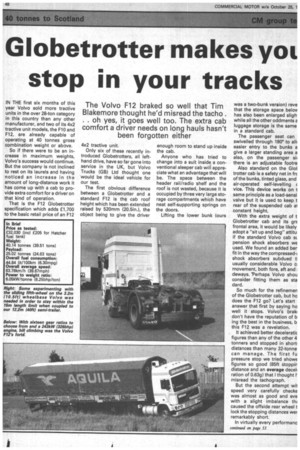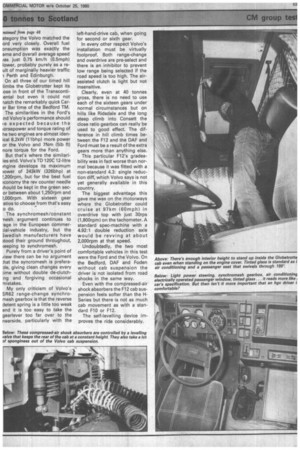Globetrotter makes yot stop in your tracks
Page 50

Page 55

If you've noticed an error in this article please click here to report it so we can fix it.
The Volvo F12 braked so well that Tim Blakemore thought he'd misread the tacho . . oh yes, it goes well too. The extra cab comfort a driver needs on long hauls hasn't been forgotten either
IN THE first six months of this year Volvo sold more tractive units in the over 28-ton category in this country than any other manufacturer, and two of its 4x2 tractive unit models, the F10 and F12, are already capable of operating at 40 tonnes gross combination weight or above.
So if there were to be an increase in maximum weights, Volvo's success would continue. But the company is not inclined to rest on its laurels and having noticed an increase in the amount of long-distance work it has come up with a cab to provide extra comfort for a driver on that kind of operation.
That is the F12 Globetrotter specification which adds £1,700 to the basic retail price of an F12 4x2 tractive unit.
Only six of these recently introduced Globetrotters, all lefthand drive, have so far gone into service in the UK, but Volvo Trucks (GB) Ltd thought one would be the ideal vehicle for our test.
The first obvious difference between a Globetrotter and a standard F12 is the cab roof height which has been extended raised by 520mm (20.5in.), the object being to give the driver enough room to stand up inside the cab.
Anyone who has tried to change into a suit inside a conventional sleeper cab will appreciate what an advantage that will be. The space between the header rail/radio shelf and the roof is not wasted, because it is occupied by three very large storage compartments which have neat self-supporting springs on the doors.
Lifting the lower bunk (ours was a two-bunk version) reve that the storage space belov has also been enlarged sligh while all the other oddments a luggage storage is the same in a standard cab.
The passenger seat can swivelled through 1800 to all easier entry to the bunks a give a larger standing area a also, on the passenger sii there is an adjustable footre
Also standard on the Gloi trotter cab is a safety net in frc of the bunks, tinted glass, and air-operated self-levelling ( vice. This device works on t same principle as a load-sensi valve but it is used to keep t rear of the suspended cab at constant height.
With the extra weight of t Globetrotter cab and its gr€ frontal area, it would be likely adopt a "sit up and beg" attitu if the standard Volvo cab st pension shock absorbers we used. We found an added ber fit in the way the compressedshock absorbers subdued ti usually considerable Volvo c; movement, both fore, aft and : deways. 'Perhaps Volvo shou consider fitting them as sta dard.
So much for the refinemen of the Globetrotter cab, but ho does the F12 go? Let's start answer that first by saying ho well it stops. Volvo's braki don't have the reputation of b ing the best in the business, b this F12 was a revelation.
It achieved better deceleratic figures than any of the other 4 tonners and stopped in short distances than many 32-tonne can manage. The first fu pressure stop we tried show€ figures so good (85ft stoppir distance and an average decell ration of 0.63g) that I thought l' misread the tachograph.
But the second attempt wit speed very carefully checke was almost as good and eve with a slight imbalance tIN caused the offside rear wheel t lock the stopping distances wet remarkably short.
In virtually every performanc continued on page 53 ategory the Volvo matched the ord very closely. Overall fuel onsumption was exactly the ame and overall average speed /as just 0.75 km/h (0.5mph) lower, probably purely as a reult of marginally heavier traffic 1 Perth and Edinburgh.
On all three of our timed hill limbs the Globetrotter kept its ose in front of the Transconti ental but even it could not latch the remarkably quick Car3r Bar time of the Bedford TM, The similarities in the Ford's rid Volvo's performance should le expected because the iorsepower and torque rating of he two engines are almost iden ical 8.2kW (11bhp) more power or the Volvo and 7Nm (5Ib ft) nore torque for the Ford.
But that's where the sinnilariies end. Volvo's TD 120C 12-litre ngine develops its maximum mwer of 243kW (326bhp) at !,200rpm, but for the best fuel conomy the rev counter needle ihould be kept in the green sec or between about 1,250rpm and ?,000rpm. With sixteen gear :atios to choose from that's easy o do.
The synchromesh/constant mesh argument continues to :age in the European commer;jai-vehicle industry, but the 3wedish manufacturers have :itood their ground throughout, (eeping to synchromesh.
Purely from a driver's point of riew there can be no argument :hat the syncromesh is preferaple, giving clean changes every :ime without double de-clutchng and forgiving occasional mistakes.
My only criticism of Volvo's 5R62 range-change synchro mesh gearbox is that the reverse detent spring is a little too weak and it is too easy to take the gearlever too far over to the nearside, particularly with the left-hand-drive cab, when going for second or sixth gear.
In every other respect Volvo's installation must be virtually foolproof. Both range-change and overdrive are pre-select and there is an inhibitor to prevent low range being selected if the road speed is too high. The airassisted clutch is light but not insensitive.
Clearly, even at 40 tonnes gross, there is no need to use each of the sixteen gears under normal circumstances but on hills like Ridsdale and the long steep climb into Consett the close ratio gearbox can really be used to good effect. The difference in hill climb times between the F12 and the DAF and Ford must be a result of the extra gears more than anything else.
This particular F12's gradeability was in fact worse than normal because it was fitted with a non-standard 4.3: single reduction diff, which Volvo says is not yet generally available in this country.
The biggest advantage this gave me was on the motorways where the Globetrotter could cruise at 97km (60mph) in overdrive top with just 3Orps (1,800rpm) on the tachometer. A standard spec-machine with a 4.921 double reduction axle would be revving at about 2,000rpm at that speed.
Undoubtedly, the two most comfortable vehicles in this test were the Ford and the Volvo. On the Bedford, DAF and Foden without cab suspension the driver is not isolated from road shocks in the same way.
Even with the compressed-air shock absorbers the F12 cab suspension feels softer than the HSeries but there is not as much cab movement as with a standard F10 or F12.
The self-levelling device improves the ride considerably.
























































































































































